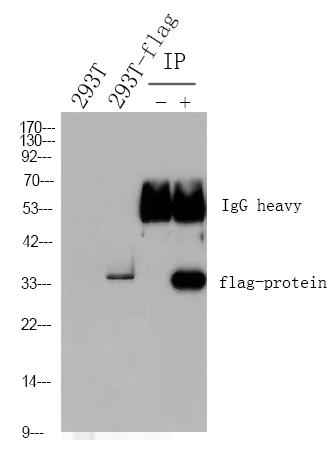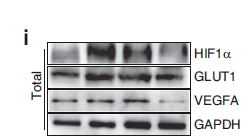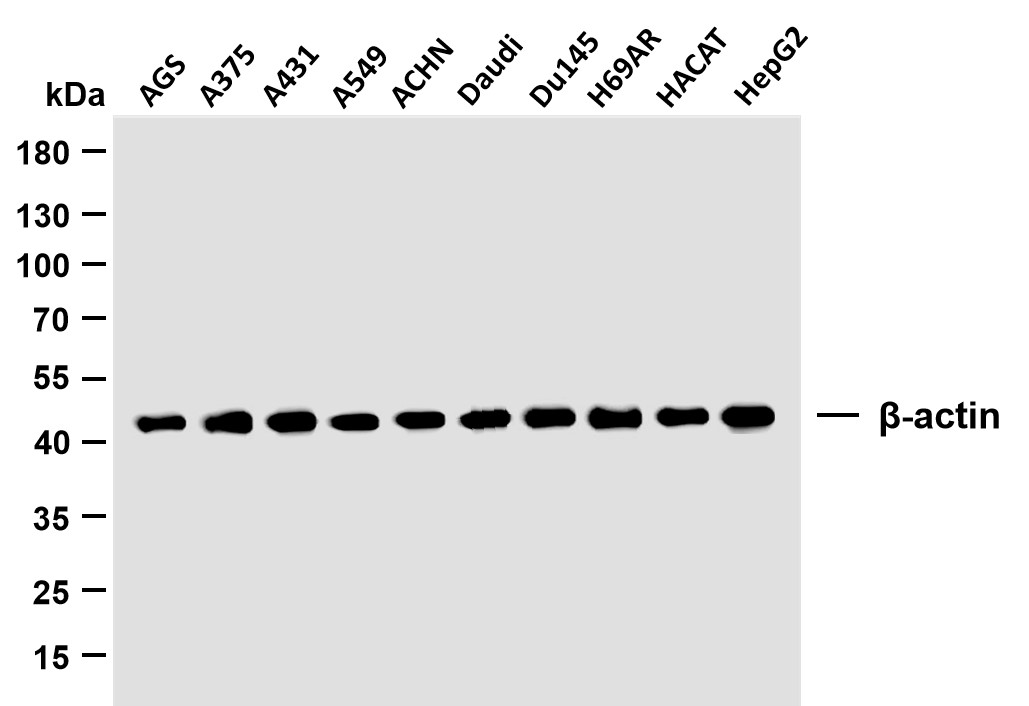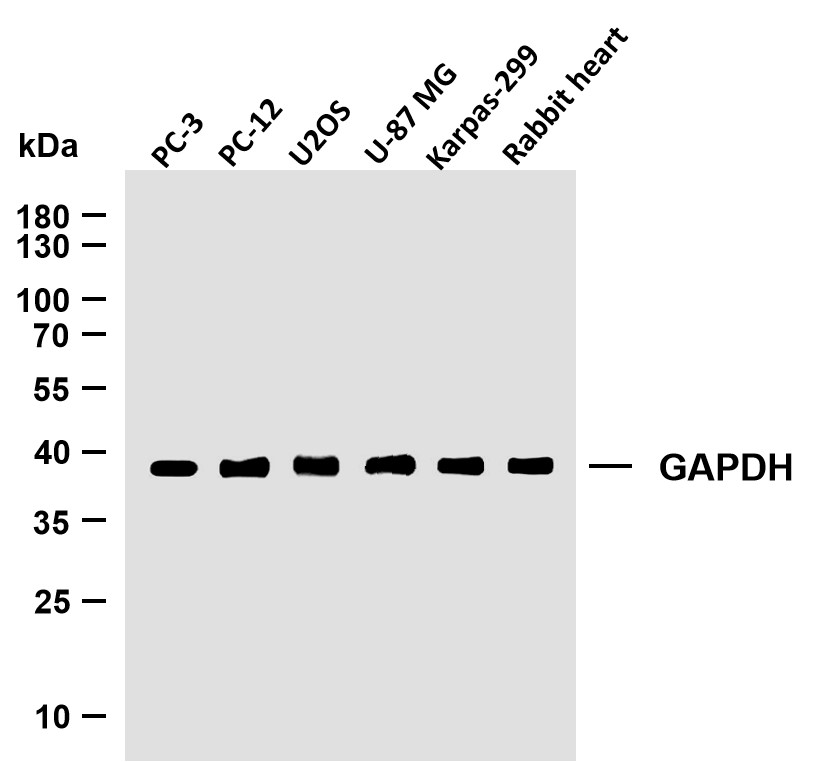
Catalog: YM0080
Size
Price
Status
Qty.
200μL
$600.00
3 weeks
0
100μL
$350.00
3 weeks
0
50μL
$210.00
3 weeks
0
Add to cart


Collected


Collect
Main Information
Target
BPTF
Host Species
Mouse
Reactivity
Human
Applications
WB, ELISA
MW
338kD (Calculated)
Conjugate/Modification
Unmodified
Detailed Information
Recommended Dilution Ratio
WB 1:500-1:2000; ELISA 1:10000; Not yet tested in other applications.
Formulation
Liquid in PBS containing 50% glycerol, 0.5% BSA and 0.02% sodium azide.
Specificity
BPTF Monoclonal Antibody detects endogenous levels of BPTF protein.
Purification
Affinity purification
Storage
-15°C to -25°C/1 year(Do not lower than -25°C)
MW(Calculated)
338kD
Modification
Unmodified
Clonality
Monoclonal
Related Products
Antigen&Target Information
Immunogen:
Purified recombinant fragment of human BPTF expressed in E. Coli.
show all
Specificity:
BPTF Monoclonal Antibody detects endogenous levels of BPTF protein.
show all
Gene Name:
BPTF
show all
Protein Name:
Nucleosome-remodeling factor subunit BPTF
show all
Other Name:
BPTF ;
FAC1 ;
FALZ ;
Nucleosome-remodeling factor subunit BPTF ;
Bromodomain and PHD finger-containing transcription factor ;
Fetal Alz-50 clone 1 protein ;
Fetal Alzheimer antigen
FAC1 ;
FALZ ;
Nucleosome-remodeling factor subunit BPTF ;
Bromodomain and PHD finger-containing transcription factor ;
Fetal Alz-50 clone 1 protein ;
Fetal Alzheimer antigen
show all
Background:
This gene was identified by the reactivity of its encoded protein to a monoclonal antibody prepared against brain homogenates from patients with Alzheimer's disease. Analysis of the original protein (fetal Alz-50 reactive clone 1, or FAC1), identified as an 810 aa protein containing a DNA-binding domain and a zinc finger motif, suggested it might play a role in the regulation of transcription. High levels of FAC1 were detected in fetal brain and in patients with neurodegenerative diseases. The protein encoded by this gene is actually much larger than originally thought, and it also contains a C-terminal bromodomain characteristic of proteins that regulate transcription during proliferation. The encoded protein is highly similar to the largest subunit of the Drosophila NURF (nucleosome remodeling factor) complex. In Drosophila, the NURF complex, which catalyzes nucleosome
show all
Function:
developmental stage:Abundantly expressed in the fetal brain. Present throughout the gray and white matter of the developing spinal cord at 18-22 gestational weeks. Expressed at low levels in adult brain and spinal cord and reexpressed in neurodegenerative diseases (at protein level).,Domain:The second PHD-type zinc finger mediates binding to histone H3-K4Me3.,Function:Histone-binding component of NURF (nucleosome-remodeling factor), a complex which catalyzes ATP-dependent nucleosome sliding and facilitates transcription of chromatin. Specifically recognizes H3 tails trimethylated on 'Lys-4' (H3-K4Me3), which mark transcription start sites of virtually all active genes. May also regulate transcription through direct binding to DNA or transcription factors.,miscellaneous:Highly susceptible to proteolysis.,PTM:Phosphorylation enhances DNA-binding. Phosphorylated upon DNA damage, probably by ATM or ATR.,sequence Caution:Several sequencing errors in the N-terminal part.,sequence Caution:Several sequencing errors.,similarity:Belongs to the PBTF family.,similarity:Contains 1 bromo domain.,similarity:Contains 1 DDT domain.,similarity:Contains 2 PHD-type zinc fingers.,subcellular location:In brains of Alzheimer disease patients, present in a subset of amyloid-containing plaques.,subunit:Interacts with MAZ. Interacts with KEAP1. Part of the nucleosome-remodeling factor (NURF) complex which consists of SMARCA1; BPTF; RBBP4 and RBBP7. Interacts with histone H3-K4Me3 and to a lesser extent with histone H3-K4Me2.,tissue specificity:Ubiquitously expressed, with highest levels in testis. Present in kidney, liver and brain. In the brain, highest levels are found in motor cortex (at protein level).,
show all
Cellular Localization:
Cytoplasm. Nucleus. In brains of Alzheimer disease patients, present in a subset of amyloid-containing plaques.
show all
Tissue Expression:
Ubiquitously expressed, with highest levels in testis. Present in kidney, liver and brain. In the brain, highest levels are found in motor cortex (at protein level).
show all
Signaling Pathway
Reference Citation({{totalcount}})
Catalog: YM0080
Size
Price
Status
Qty.
200μL
$600.00
3 weeks
0
100μL
$350.00
3 weeks
0
50μL
$210.00
3 weeks
0
Add to cart


Collected


Collect
Recently Viewed Products
Clear allPRODUCTS
CUSTOMIZED
ABOUT US
Toggle night Mode
{{pinfoXq.title || ''}}
Catalog: {{pinfoXq.catalog || ''}}
Filter:
All
{{item.name}}
{{pinfo.title}}
-{{pinfo.catalog}}
Main Information
Target
{{pinfo.target}}
Reactivity
{{pinfo.react}}
Applications
{{pinfo.applicat}}
Conjugate/Modification
{{pinfo.coupling}}/{{pinfo.modific}}
MW (kDa)
{{pinfo.mwcalc}}
Host Species
{{pinfo.hostspec}}
Isotype
{{pinfo.isotype}}
Product {{index}}/{{pcount}}
Prev
Next
{{pvTitle}}
Scroll wheel zooms the picture
{{pvDescr}}


















